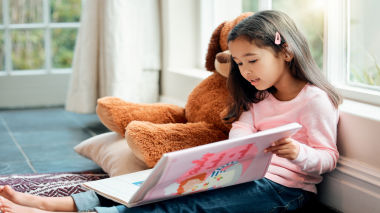Editor’s Note: This is a shortened version of an article featured in Atrium Health’s “Your Guide to Pregnancy & Motherhood.” To read more, get your free copy of the guide!
After your infant is born, they’re sure to sleep like a baby – which means they’ll be restless, crying and up every three hours. That’s how babies sleep, after all.
Jokes aside, as you enter the early, fatigue-filled days of parenthood, you’ll do whatever you can to help your newborn get the best, safest sleep possible – and this might include some form of co-sleeping. Co-sleeping is the practice of having your baby sleep close to you, instead of in a different room. As a practice, it’s been on the rise for over two decades, with no signs of slowing down anytime soon.
Research and evidence have proven that co-sleeping can keep your baby’s sleep environment safe and sound – but only when done correctly. There are a few different co-sleeping methods out there, but the most well-known are room-sharing and bed-sharing. In room-sharing, the infant sleeps in the same room as the parents, but in their own crib or bassinet. But in bed-sharing – which is the dangerous, more controversial method – the infant and parents sleep together in one, adult-sized bed.
According to Amanda Lanier, MD, a pediatrician at Atrium Health Levine Children’s Charlotte Pediatric Clinic, there’s only one proven-safe way to co-sleep with your baby. And that’s room-sharing. “In 2016, the American Academy of Pediatrics endorsed room-sharing in their safe sleep recommendations,” says Dr. Lanier. “But they firmly warned parents not to place infants to sleep on an adult-sized bed due to suffocation risks.”
While other co-sleeping methods do exist – like attachable bassinets and putting multiple infants in the same sleep space – be careful: Dr. Lanier says there hasn’t been enough research on these other methods to appropriately determine how safe they are.
Co-sleeping, The Safe Way
Room-sharing is the safest – and only – co-sleeping option currently recommended by the American Academy of Pediatrics (AAP). Keeping your sleeping baby close but separate is ideal for the first year of life and is recommended for at least the first 6 months. “Not only is room-sharing convenient for breastfeeding moms, but it can make it easier to bond with your baby and can even reduce the risk of sudden infant death syndrome by 50 percent,” says Dr. Lanier.
If you, your family and your pediatrician decide that room-sharing is the best option for your baby, the first thing you need to do is choose a safe sleep space. Dr. Lanier recommends choosing a separate crib or bassinette that meets the U.S. Consumer Product Safety Commission’s safety standards.
As you shop around, keep in mind that your baby’s mattress should be firm, not soft. And when you put the crib or bassinet together, make sure it’s secured properly and that there aren’t any gaps between the mattress and the walls.
While you put all this preparation into helping your baby sleep, don’t forget to get a good night’s rest yourself. Whether you’re breastfeeding or just holding your baby, make sure you’re fully alert and are sitting upright to avoid dozing off.
It’s easy to do, but falling asleep with your baby in your bed or even in your arms can be disastrous – and even fatal. Unlike room-sharing, bed-sharing significantly increases your baby’s risk of sudden infant death syndrome (SIDS). In fact, the biggest safety concerns surrounding co-sleeping have to do with the dangers of bed-sharing specifically.
Wherever your baby sleeps, it’s also important to make sure their space is free of any pillows, sheets, blankets and other items that could potentially lead to suffocation. For more information, Dr. Lanier recommends following the safe sleep instructions listed by the American Academy of Pediatrics.
Is Co-sleeping Good or Bad?
So, is co-sleeping ever a good idea? If you’re talking about room-sharing, the answer is a resounding yes.
Room-sharing continues to be the safest – and only – recommended form of co-sleeping. But you’ll be hard-pressed to find a pediatrician who can say the same about bed-sharing. “While bed-sharing might seem convenient and comforting, the safest place for your baby is on a separate sleep surface in your room,” says Dr. Lanier.
As a parent, you almost always know best – but this might be a good time to take your pediatrician’s advice and co-sleep, the safe way. After all, you’re going to lose sleep as a parent, but you could lose so much more if you don’t take the right precautions.
Like this article? Want to see more like it? Get a free copy of Atrium Health’s “Your Guide to Pregnancy & Motherhood”!



